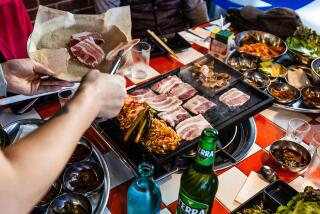Outdoor grill industry tries to keep sales sizzling

- Share via
It’s a rite of summer, especially on July 4: Grilling on the outdoor barbecue.
Cooking hamburgers, hot dogs and steaks on an outdoor grill is such an ingrained part of Americana, and a grill is such an established feature of homeownership, that 3 out of 4 U.S. adults own a grill or smoker.
Demand for the outdoor grill also is egalitarian, not unlike the television set. They’re found everywhere – from the backyards of posh Beverly Hills homes to the infields of NASCAR speedways.
But the fact that grills are so commonplace is one reason why there’s only modest sizzle in new-product sales for the U.S. barbecue and grill manufacturing industry. It’s simply a mature business.
Grill sales in America are growing only by low single-digit percentages each year, and the market is nearly 20% smaller than it was a decade ago, according to the research firm IBISWorld.
U.S. grill manufacturers — led by Weber-Stephen Products, maker of the iconic Weber grills — also face stiff competition from imports, which now account for 56% of U.S. sales, up from 46% a decade ago, the IBISWorld data show.
Grill sales are closely tied to changes in the U.S. economy, especially the housing industry. So, not surprisingly, the grill business was hammered between 2008 and 2010 when the housing crisis and severe recession took hold.
The industry has been gradually recovering since then in step with the economy’s rebound, with annual U.S. grill sales climbing to $1.44 billion last year from $1.21 billion in 2009, according to IBISWorld. But that’s well below the $1.78 billion in sales in 2006.
“We think we’ll continue to see steady sales,” said Carrie deGuzman, a spokeswoman for the Hearth, Patio & Barbecue Assn., the industry’s trade group.
The Fourth of July is the most popular day of the year for outdoor grilling, with 76% of grill owners planning to fire up their barbecues on the holiday, the HPBA says. Those summer bookends, Memorial Day and Labor Day, tied for second place at 62%.
In the group’s most recent consumer survey, conducted last summer, 37% of U.S. adults planned to buy a new grill or smoker this year; 56% of those purchases would be for replacement grills.
And in the heated debate between gas and charcoal, gas has the edge. Gas grills outsold charcoal grills, 57.7% to 40.1%. The remaining 2.2% of grills sold were electric.
The millennial generation — buyers ages 18 to 34 — is just as hooked on outdoor grilling as its forebears, partly because they watch “BBQ Pitmasters” and other cooking shows on television, said Richard Wachtel, founder of the barbecue website GrillingWithRich.com.
“People are looking to bring those barbecue techniques home,” he said.
The word “barbecue,” incidentally, dates back hundreds of years to the Caribbean words “barabicu” or “barbacoa,” which was a wooden structure used by the Taino people to smoke food, according to some etymologists. Later it also became a verb for outdoor grilling.
The leading U.S. grill supplier is Weber-Stephen with 30.3% of the market by dollar sales, according to IBISWorld. Next is Middleby Corp., an Elgin, Ill.-based company that has a 16.6% share with brands that include MagiKitch’n and Viking.
Last December, Middleby acquired Downey-based Lynx Grills Inc., a maker of high-end outdoor grills that include some elaborate models that are voice-activated and can cost more than $8,000.
Weber has been growing faster than the overall market in recent years, aided by its brand recognition, product reputation, the improved economy and higher exports.
The Palatine, Ill.-based company is privately held and doesn’t disclose financial data. But IBISWorld estimates that Weber-Stephen’s global grill sales have grown an average 10% a year for the last five years, to $235 million in 2015.
Weber traces its roots to 1952 when George Stephen Sr. was working at Weber Brothers Metal Works in Chicago, which made marine buoys. He invented a dome-shaped grill from cutting a buoy in half, to protect food from the elements while sealing in the smoke and barbecue flavor.
Four years later, Stephen redesigned the Weber to look more like the grill’s familiar kettle shape in use today.
The company’s product line now includes gas, charcoal and electric outdoor grills, some of which can cost thousands of dollars.
“It’s a great product, they have great customer service and sell many different models,” Wachtel said. “Their traditional kettle grill has stood the test of time.”
The best-selling imported outdoor grills include the Char-Broil models made in China by 131-year-old W.C. Bradley Co., a privately held company based in Columbus, Ga.
Bradley moved the grills’ production from Georgia to China in 2006.
At the time, Bradley said that production costs were 25% lower in China and that the company made the move “to remain competitive in a dramatically changing marketplace.”
A decade later, one of the industry’s key changes is adapting to consumers’ desire to barbecue a wider variety of foods, so firms are offering more accessories for outdoor grills beyond such staples as cleaning brushes, tongs and hand mitts.
Among the most popular new add-ons: Pizza stones, fish or broiling baskets and grill woks.
“They really speak to the culinary adventure and quality food movement that people want,” DeGuzman said.
Weber likewise maintains that “staying on top of trends and what our customers want is a huge priority for us,” Kim Lefko, Weber-Stephen’s chief marketing officer, said in an email.
An example: Weber recently introduced its Q1200 line of portable grills, which “really struck a chord with millennials” partly because they are suited for apartment balconies and tailgate parties, Lefko said.
The Q1200 grills also come in youthful colors that might make a traditional silver-and-black grill jockey cringe, including purple, pink and lime green.
Overall, outdoor grill sales should keep modestly rising the next few years provided the economy keeps growing and consumers have enough disposable income, IBISWorld analyst Edward Rivera said.
After all, Rivera said, “it’s part of the American identity to have a grill.”
More to Read
Inside the business of entertainment
The Wide Shot brings you news, analysis and insights on everything from streaming wars to production — and what it all means for the future.
You may occasionally receive promotional content from the Los Angeles Times.











